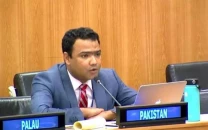One heck of a time travel
Looking at the darkening outlook of the global breathing space, long gone are the days of nature poetry

The writer is a Pakistan enthusiast and an MPhil student at GIDS, Lahore School of Economics. He can be reached at atif.ilyas@hotmail.com
With a slide of mosquito in the backdrop, director of Global Health Institute Dr Jonathan Patz stated that ‘global warming’s greatest threat may also be the smallest’. It could not be said any better because presently, the whole world, predominantly the warmer regions like South Asia and Africa, are reeling from vector-borne maladies like malaria and dengue. Climate change has aggravated the transmission of these diseases not just via natural disasters like floods which provide stagnant pools for mosquitoes to colonise, but also via increased temperatures. There exists a clear biographical pattern that tropics have greater species diversity due to higher temperatures resulting from lower latitudes. Such is the case because warmer temperatures provide the energy that increase the raw material for the speciation to act on, which causes infectious parasites and pathogens to multiply faster in climate-induced heat in the already simmering tropics.
With a reported burden of 1.5 million cases annually, Pakistan has seen the worst of vector-borne diseases so much that the WHO has enlisted it in the ‘group three’ countries in the WHO Eastern Mediterranean Region that include Djibouti, Afghanistan, and Somalia. Last year, Pakistan had to bear titanic burden of climate enabled viral infections, including outbreaks of dengue and locally lesser known infections like chikungunya and Congo fever. Water does not only give sweet dwellings to the eggs of these diseases, but also carry in itself ghosts of its own. Exaggerated precipitation leads to the contamination of surface water due to sewerage overflows that carry infectious diseases varying in severity from mild gastroenteritis to potentially fatal ailments like hepatitis, cholera and dysentery. According to figures published in PES 2016, a quarter million children under five die every year due to diarrhoeal diseases. Furthermore, NCS claims that 40 percent of all diseases reported in Pakistan are because of drinking polluted water.
The overall relationship between climate change and health is complicated, because the former acts in a complicated cascade coupling up with other factors like feeble protective measures, poverty and geographical location to exacerbate the situation. But, the strong causal linkage of respiratory diseases leaves a lot less to the imagination because air pollution that drives climate change has an intimate link with health. According to Climate Change Minister Mushahidullah Khan, some 14 million Pakistanis are living with asthma and this tally could experience an annual increase of 30 per cent.
Though, direct after-shocks of air pollution are felt stronger by the global North, but it has been relatively immune to the vector-borne diseases due to colder temperatures resulting from higher latitudes. But as the planet heats up and the North waits with fingers crossed for these pathogens to breach the barrier and move northwards, climate change has brought out another rabbit out of its hat — resurrection of mummified remains of the past transgressors.
For multitudes of years, Siberian permafrost has been a ginormous mass of frost that has kept the ghosts of the past buried and forgotten. But last year as Siberia went through a heatwave, the permafrost thawed and rejuvenated the long dormant spores of anthrax from the carcass of an infected reindeer. The spores infected two dozen people and even killed one in the remote Yamal Peninsula. Not only anthrax, many other long dormant pathogens that include small pox and bubonic plague are feared to revive as the permafrost keeps on melting.
Adding to the horrors, aggregate remains of ancient animals and plants buried in permafrost are estimated to add 1,500 billion carbon to the atmosphere. Not only that, microbes love to feast on such mulch and resultantly release carbon dioxide which would further warm the climate leading to an unending warming cycle. To make matters worse, this permafrost that Robert Spencer calls a ‘silent ticking time bomb’ is expected to engender massive releases of methane gas, which is 30 times stronger GHG than carbon dioxide. Over the past three years, 14 giant craters are found in this region due to methane explosions, and there also exist reports of ‘ground trembling’ in Siberia taking place due to methane gas bubbling under the surface while escaping from the permafrost.
According to the WHO, presently an estimated 12.6 million deaths each year are caused by unhealthy environments, and in the light of afore-discussed preparation done by climate change, a lot worse can be expected. I should end this piece by highlighting that how much effort is needed to avert this crisis, but instead let’s take a back seat and applaud how extensively our foe is working to increase our woes; time travelling its way to predict our sorry future by affecting our present and resurrecting our past. In my last article, I urged my readers to learn from the blind man allegory that how he covers more bases to avoid a jam, but maybe we can learn the best from our biggest adversary till date — climate change.
Published in The Express Tribune, November 11th, 2017.
Like Opinion & Editorial on Facebook, follow @ETOpEd on Twitter to receive all updates on all our daily pieces.



















COMMENTS
Comments are moderated and generally will be posted if they are on-topic and not abusive.
For more information, please see our Comments FAQ